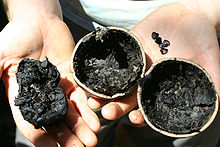- Crescentia alata
-
Crescentia alata 
Scientific classification Kingdom: Plantae (unranked): Angiosperms (unranked): Eudicots (unranked): Asterids Order: Lamiales Family: Bignoniaceae Genus: Crescentia Species: C. alata Binomial name Crescentia alata
KunthCrescentia alata (variously called Mexican Calabash, Jicaro, Morrito, Winged Calabash [1]) is a species in the trumpet-flower family Bignoniaceae, native to southern Mexico and Central America south to Costa Rica.
It is a small tree growing to 8 m tall. It has hard, cannonball-like fruit 7-10 cm diameter, that are difficult to break into. It is believed that these fruit characteristics evolved as a defense mechanism against seed predation. However, it seems to be a counter-productive strategy, as the seeds inside the fruits never germinate unless the fruits are broken open, and with the exception of horses and humans, no animals break open the fruits.
While it has been observed that domestic horses may smash the fruit with their hooves and eat the pulp and seeds (suggesting that they may serve as seed distribution vectors), horses were only very recently (in evolutionary time) introduced to the native range of C. alata, which implies that C. alata evolved thick-walled, impenetrable fruits long before the introduction of horses to its native range. So the question remains: how did C. alata evolve a defense mechanism (impenetrable fruits) that entirely prevents the germination of its seeds?.
Daniel Janzen suggested that Gomphotheres (extinct elephant-like animals) may have previously been responsible for the dispersal of C. alata seeds[2]. With their extinction, C. alata became threatened with the possibility of habitat loss and suffered an extremely limited ability to migrate, but the introduction of a new vector, in the form of domestic horses, has allowed the species to maintain its viability. C. alata is, not surprisingly, most often found in open areas, such as pastures and fields. It is also cultivated for its gourd-like fruits, which may be hollowed and dried and used as containers for food and drink.
The fruit plays a role in the Popol Vuh (book of myths of the Mayan civilization). After the first generation of hero twins, 1 Hunajpu and 7 Hunajpu, fail and are killed in the ball game in Xibalba, the demonic Xibalbans hang their skull in this tree. This is presumably a mythic justification for the resemblance of the fruit to skulls and the carrion smell of the tree in flower (scientifically justified because it is pollinated by flies). The skull later spits in the hand of the Xibalban princess Ixquic, thus impregnating her and begetting the second, successful generation of Maya Hero Twins.
The seeds are edible and high in protein with a licorice-like sweet taste, used in Honduras, El Salvador and Nicaragua to make a kind of horchata called Semilla de Jicaro.[3]
References
- ^ Crescentia Alata, Stephen H Brown, Factsheet, Lee County Extension Gardening Publications, University of Florida
- ^ Janzen, D. H., and Martin, P. S. 1982. Neotropical anachronisms: The fruits the gomphotheres ate. Science 215:19-27.
- ^ Flowering plants, dicotyledons: Lamiales (except Acanthaceae including Avicenniaceae), Joachim W. Kadereit, Springer, 2004, ISBN 3540405933, Google Books
Categories:- Crescentia
- Trees of Belize
- Trees of Costa Rica
- Trees of El Salvador
- Trees of Guatemala
- Trees of Honduras
- Trees of Southern Mexico
- Trees of Nicaragua
Wikimedia Foundation. 2010.

